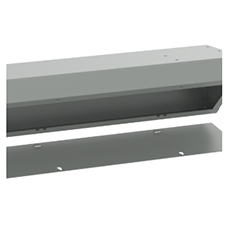
Cable and Conductor Management: Wiring Troughs and More
Steve Maurer, IME
There have been many times when I was elbows deep in a wiring trough or raceway. We sometimes called the smaller units gutters, but all were raceways and wiring troughs.
While most of the conductors and cables in the plant were run in conduit, also another type of raceway, many times dropping legs off the main conduit meant a lot of work.
Obviously, tees and cross tees allowed you to change direction for some conductors while carrying on down the run with others. And when installing a run, that wasn’t too bad an option if the drops or tees weren’t too close together, or too frequent.
For example, in a production area where several machines were served off the same trunk line, putting in tees to run the mains to each individual machine is, and probably always will be, the most common practice.
However, in motor control center rooms and electrical/mechanical utility rooms, the best way to make multiple drops to cabinets usually employs the installation of wiring troughs or raceways. The long rectangular boxes make it easier to drop down to the right location along its length.
When feeding in or out of motor control panels, an overhead trough allows more precise placement of the conduits.
In one equipment room I’ve worked in extensively, the troughs lined all four walls, connected at the corners. The troughs were set down from the ceiling to allow conduit to come out from the top, then penetrate out through the walls into other rooms by using sweeps or LB conduit bodies.
Obviously, troughs make it easier to trace individual circuits or bundles when during installation or troubleshooting. With a wide door opening on the front, it’s much easier to segregate the wires as they’re much easier to identify.
The doors on some of the larger models could be a real pain to manipulate, however. In most cases, the trough door must be removed from the raceway itself. If you have two or more workers, this isn’t normally an issue, although it can mean some strenuous ladder work if the trough is mounted quite high on the wall next to the ceiling.
Those constructed with hinged covers are somewhat easier to handle. With screws to secure just one side of the cover, swinging the cover up and out of the way keeps everything close at hand. And if you need to leave the location temporarily, the door can be swung back into place to ensure there are no exposed wires.
I’ve recently been introduced to a rather unique style of raceway trough. Most of the time, I’ve worked with rectangular or square troughs that were mounted either snugly to the ceiling or very close to it. Conduit penetrations into the trough were made from the sides, with conduits dropped from the bottom to penetrate into the cabinets or enclosures below them.
But if a run of conduit needed installed across the ceiling, it often meant the trough had to be lowered several feet below the ceiling level to allow for the proper bend radius to be used. The sweeps and other condulets needed room to make the bend.
However, the wiring trough I found has a unique design that allows conduit penetrations from the front side of the raceway.
It’s an angled front trough with a removable cover. At the top front side of the trough, there is enough space to allow straight conduit to be attached for overhead runs. The cover can still be easily removed to give access to the interior of the trough for cable management and troubleshooting.
The bottom of the trough is wide enough to make vertical drops into enclosures below it.
Since the raceway’s angled design doesn’t require topside conduit penetrations for horizontal ceiling runs, it can be mounted much closer to the ceiling for a cleaner looking installation.
The trough cover isn’t hinged. However, the bottom side of the cover attaches to the trough using a tab and slot configuration. Fastening screws are only necessary at the top and this makes the removal and replacement of the cover much easier than having screws along both the top and bottom of the raceway cover.
Since the angled trough comes pre-manufactured in various standard lengths, depths, and heights, specifying them for enclosure and cabinet sizes is business as usual.
Additionally, if the enclosure is mounted mid wall, the angled trough can be placed at floor level if the installation requires it.
While most of the conductors and cables in the plant were run in conduit, also another type of raceway, many times dropping legs off the main conduit meant a lot of work.
Obviously, tees and cross tees allowed you to change direction for some conductors while carrying on down the run with others. And when installing a run, that wasn’t too bad an option if the drops or tees weren’t too close together, or too frequent.
For example, in a production area where several machines were served off the same trunk line, putting in tees to run the mains to each individual machine is, and probably always will be, the most common practice.
However, in motor control center rooms and electrical/mechanical utility rooms, the best way to make multiple drops to cabinets usually employs the installation of wiring troughs or raceways. The long rectangular boxes make it easier to drop down to the right location along its length.
When feeding in or out of motor control panels, an overhead trough allows more precise placement of the conduits.
In one equipment room I’ve worked in extensively, the troughs lined all four walls, connected at the corners. The troughs were set down from the ceiling to allow conduit to come out from the top, then penetrate out through the walls into other rooms by using sweeps or LB conduit bodies.
Obviously, troughs make it easier to trace individual circuits or bundles when during installation or troubleshooting. With a wide door opening on the front, it’s much easier to segregate the wires as they’re much easier to identify.
The doors on some of the larger models could be a real pain to manipulate, however. In most cases, the trough door must be removed from the raceway itself. If you have two or more workers, this isn’t normally an issue, although it can mean some strenuous ladder work if the trough is mounted quite high on the wall next to the ceiling.
Those constructed with hinged covers are somewhat easier to handle. With screws to secure just one side of the cover, swinging the cover up and out of the way keeps everything close at hand. And if you need to leave the location temporarily, the door can be swung back into place to ensure there are no exposed wires.
I’ve recently been introduced to a rather unique style of raceway trough. Most of the time, I’ve worked with rectangular or square troughs that were mounted either snugly to the ceiling or very close to it. Conduit penetrations into the trough were made from the sides, with conduits dropped from the bottom to penetrate into the cabinets or enclosures below them.
But if a run of conduit needed installed across the ceiling, it often meant the trough had to be lowered several feet below the ceiling level to allow for the proper bend radius to be used. The sweeps and other condulets needed room to make the bend.
However, the wiring trough I found has a unique design that allows conduit penetrations from the front side of the raceway.
It’s an angled front trough with a removable cover. At the top front side of the trough, there is enough space to allow straight conduit to be attached for overhead runs. The cover can still be easily removed to give access to the interior of the trough for cable management and troubleshooting.
The bottom of the trough is wide enough to make vertical drops into enclosures below it.
Since the raceway’s angled design doesn’t require topside conduit penetrations for horizontal ceiling runs, it can be mounted much closer to the ceiling for a cleaner looking installation.
The trough cover isn’t hinged. However, the bottom side of the cover attaches to the trough using a tab and slot configuration. Fastening screws are only necessary at the top and this makes the removal and replacement of the cover much easier than having screws along both the top and bottom of the raceway cover.
Since the angled trough comes pre-manufactured in various standard lengths, depths, and heights, specifying them for enclosure and cabinet sizes is business as usual.
Additionally, if the enclosure is mounted mid wall, the angled trough can be placed at floor level if the installation requires it.
Photo courtesy of nVent Hoffman







